A New Way to Train AI: Critique Fine-Tuning (CFT)
- 09 Mar 2025
- Ai
- by alasbahimoha
Recently, a group of Chinese researchers from places like Carnegie Mellon University (CMU) came up with a fresh idea called “Critique Fine-Tuning” (CFT). This method trains AI using just 50,000 examples and still beats older techniques that need over 2 million examples in most tests.
Imitation of The Old Way of Teaching AI
Large Language Models (LLMs); the smart AI systems that help solve real-world problems; often rely on a technique called Supervised Fine-Tuning (SFT) to get better.
In SFT, the AI learns by copying high-quality answers, either written by people or created by other programs. This helps the AI follow instructions well. To make these training examples, researchers use tools like Self-Instruct and Evol-Instruct.
But there’s a catch. As you give SFT more and better examples, it doesn’t always improve much. Sometimes, if the AI is already good, adding SFT can even make it worse!
Critique Fine-Tuning: A Smarter Upgrade
Three Chinese researchers from Carnegie Mellon University (CMU), the University of Waterloo, and other schools wrote a paper introducing a smarter way to train AI: Critique Fine-Tuning (CFT). Instead of just copying answers like the old method, CFT teaches the AI to think critically about them. This makes the AI learn better and deeper from its examples.

How CFT Works
CFT moves away from simply copying and focuses on learning through critique—similar to how humans learn. Think about top students: they don’t just memorize answers; they study them, spot mistakes, and figure out how to make them better.
In CFT, the training examples include wrong answers along with explanations (critiques) about what’s wrong. The AI learns from these critiques, so it can spot errors, suggest fixes, and check if answers are right. This helps the AI get better at reasoning and handling tricky problems.
Let’s look at this problem:
You have a right triangle with sides of 3 units and 4 units. Build a square with it. What’s the area of pentagon ABCDE (in square units)?
- With SFT (the old way): The AI does the math step-by-step. It uses the Pythagorean theorem to find the hypotenuse (5 units), calculates the square’s area (25), and the triangle’s area (6). Then it subtracts 6 from 25 and says the answer is (25-6) but that’s wrong.
- With CFT (the new way): The AI looks at the same problem but critiques the mistake. It says, “Wait, you don’t subtract the triangle’s area, you add it!” Then it fixes the answer to 31, which is correct.
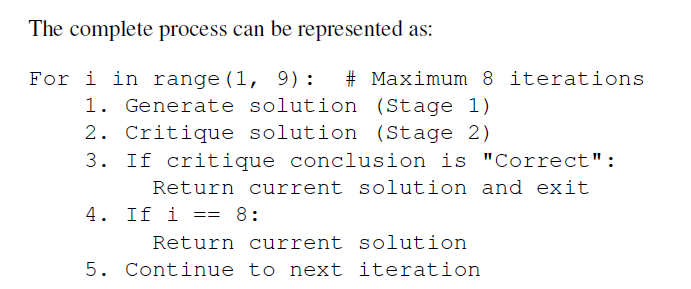
SFT vs. CFT
- SFT: Teaches the AI to copy answers directly.
- CFT: Teaches the AI to critique wrong answers and learn from them.

Here’s a quick look at how their training examples differ:
- CFT gives the AI a wrong answer plus a critique to study.
- SFT gives the AI an answer to repeat.
High Training Efficiency of CFT
How is CFT Training Data Obtained?
The paper constructs a training dataset of 50K Q&A pairs with critiques, derived from WebInstruct. These critiques are generated by advanced models like GPT-4o. The above problem is one example. Most questions in the dataset focus on mathematics (65%) but also cover physics, chemistry, business, and other subjects.
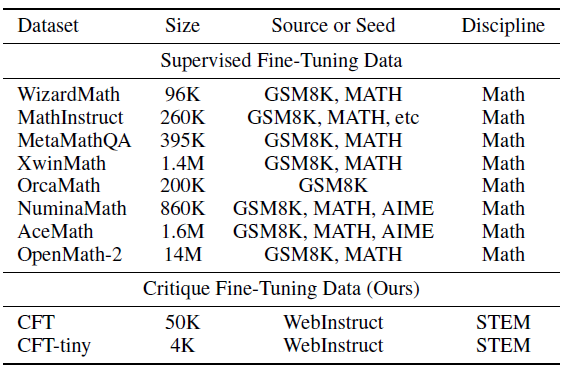
Comparing CFT and Other SFT Datasets
The researchers trained 7B-parameter instruction-untuned LLMs (such as DeepSeekMath-base, Qwen2.5, and Qwen2.5-Math) on the CFT dataset.
The training objective is straightforward: concatenate a problem x and an incorrect response y as input, then optimize model parameters to generate a critique c. In essence, the model learns critical thinking skills.

Experimental Results: CFT Outperforms SFT
The researchers evaluated how LLMs performed on math-related benchmarks after instruction fine-tuning and critique fine-tuning. Results showed that CFT-trained models consistently outperformed the best SFT-trained models.
Compared to SFT, CFT improved accuracy by 4-10 percentage points on average. Additionally, CFT training was more efficient, requiring less data and converging faster, making it a promising method for developing mathematical reasoning models.
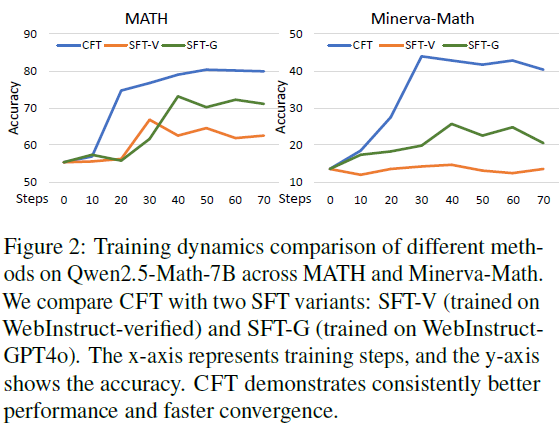
Performance Comparisons
The following chart compares the training dynamics of different methods, including CFT and two SFT variants, using Qwen2.5-Math-7B on MATH and Minerva-Math. The x-axis represents training steps, while the y-axis shows accuracy.

Even when trained on the same 50K samples, models using CFT showed greater performance improvements compared to SFT-trained models.
CFT vs. Large-Scale Models
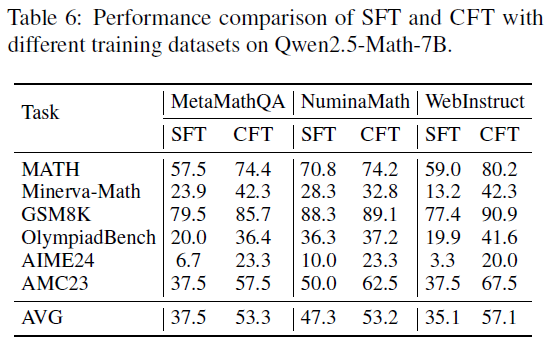
The researchers compared the fine-tuned Qwen2.5-Math-7B-CFT with well-known models such as Llama, GPT series, and other reasoning-specialized models like DeepSeek, Mathstral, and Numina. The results are shown below:
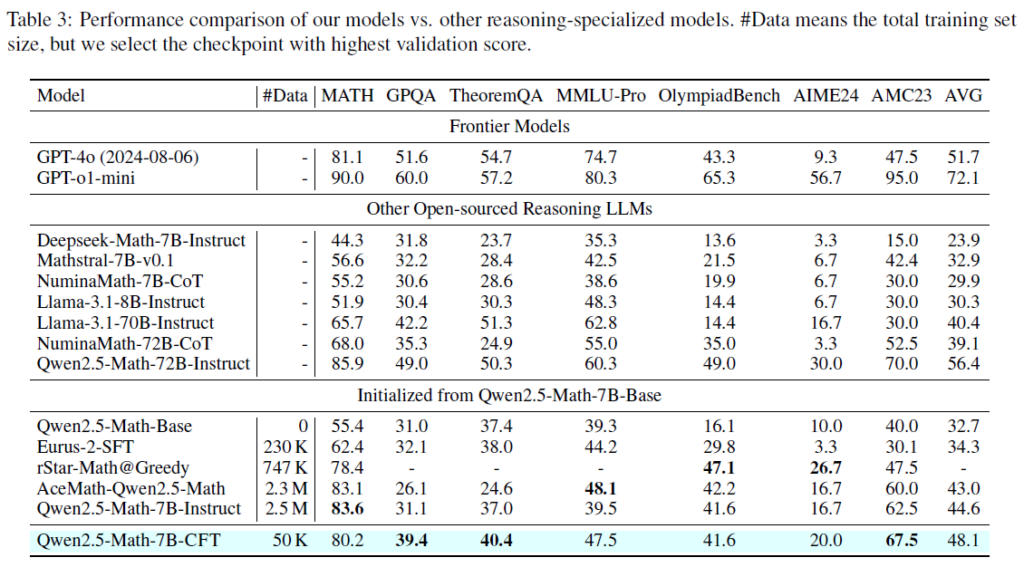
- Qwen2.5-Math-7B-CFT achieved an average accuracy of 48.1%, surpassing larger models such as Llama-3.1-70B-Instruct (40.4%) and NuminaMath-72B-CoT (39.1%).
- Its performance is comparable to Qwen2.5-Math-72B-Instruct (56.4%), which has 10 times the parameters.
- CFT-trained models rivaled SimpleRL models (public reproduction of DeepSeek R1) trained with 140 times more computational resources while using only 1/144th of the GPU hours, significantly reducing computing costs.
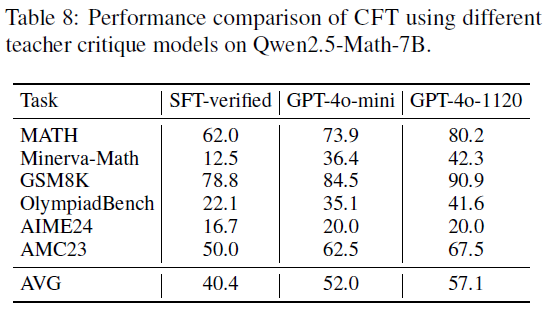
Limitations and Future Directions
Challenges of CFT
- The critique data in CFT training is generated by LLMs. A manual review of 50 samples found that 20% contained incorrect critiques. These errors could negatively impact model training and final performance.
- Current CFT-trained models lack self-critique abilities, so self-improvement has not yet been observed.
- The dataset mainly focuses on mathematics. Whether CFT can be extended to programming, scientific, or even humanities-related reasoning tasks remains uncertain.
Advantages and Future Research
CFT’s key advantage is its significant boost to reasoning ability and efficient data utilization. By teaching models to critique, CFT functions as a single-step reinforcement learning approach.
Compared to self-correction and reward modeling, CFT aims to improve problem comprehension through critique-based learning rather than direct reward estimation or self-correction. This makes it more adaptable and flexible in reasoning tasks.
Crucially, CFT’s data construction and training process are simple and cost-effective, making it highly practical for real-world applications. Future research may focus on improving critique data quality and exploring self-critique mechanisms.
Potential directions include:
- Developing automated verification tools or human-validated critique datasets to enhance critique quality.
- Enabling self-critique and self-improvement by incorporating user feedback to continuously refine models.
- Integrating CFT with other training paradigms such as SFT and RL, expanding into multimodal environments, and studying its theoretical foundations.